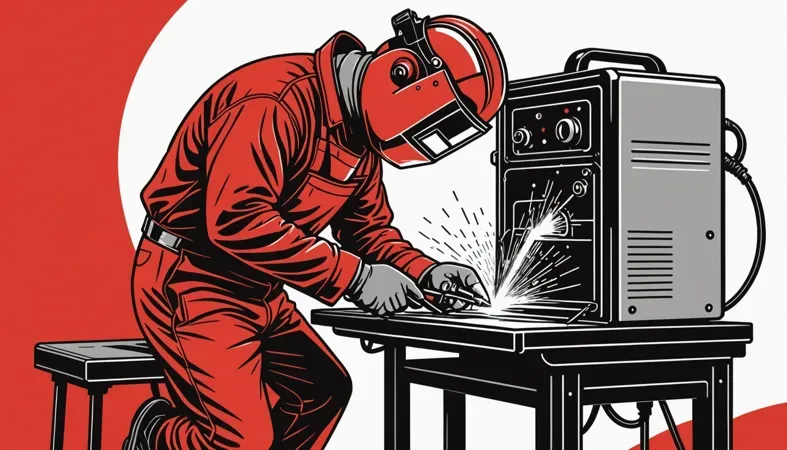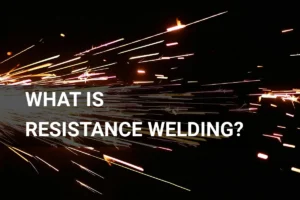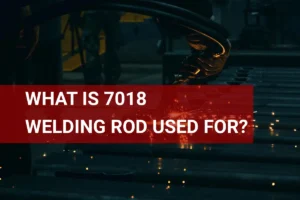How to Flux Core Weld? A Complete Guide on Techniques, Tools, and Tips
Published on: June 26, 2025 | Last modified: March 4, 2025
By: Joe Carter
Flux core is a type of welding process that uses a tubular wire filled with flux. This flux creates a shielding gas when you weld, protecting your work from contamination.
Many people have asked me about how to flux core weld. It’s crucial to get this right, as poor technique can lead to weak joints. From my experience, following the steps carefully can save you from headaches down the road.
In this guide, I’ll cover what flux core welding is, the different types, necessities for setup, key steps, safety precautions, common issues, cleaning and inspection, benefits, applications, and alternative methods to consider. You’ll also learn how to set up a flux core welder effectively. Let’s dive in!
Contents
- How to Flux Core Weld?
- What is Flux Core?
- Types Of Flux Core in Relation to Welding
- Prerequisites: Things You’ll Need for Flux Core Welding
- Steps to Flux Core Weld
- Precautions
- Types Of Flux Core Welding Processes
- Factors Affecting Flux Core Welding
- Common Issues and Troubleshooting
- Aftercare, Inspection, and Advanced Tips for Flux Core Welding
- Advanced Techniques for Flux Core Welding
- Key Benefits Of Flux Core Welding
- Applications You Should Know About
- Exploring Alternatives to Flux Core Welding
- Frequently Asked Questions (FAQs)
- Conclusion
- Additional Reading
How to Flux Core Weld?
Flux core welding involves using a continuous hollow wire filled with flux. To flux core weld, adjust your welder to 0.030-0.045 inches (0.76-1.14 Mm) wire. This technique’s easy and suits outdoor jobs, but it can create more spatter.
What is Flux Core?
Flux core welding uses a tubular wire filled with flux. An electrical arc generates high heat, melting the wire and base metal together. The flux protects the weld from contamination. This process can reach temperatures up to 2,500°F (1,370°C).
Now, let’s cover how to flux core weld. You’ll need a flux-core welder and basic gear. I remember my first time; the setup wasn’t as tricky as I’d thought, but knowing the proper techniques made a significant difference.
I once used it to fix old farm equipment. It’s not always recommended for thin metal, but it worked like a charm for me. When learning to use a flux welder, understanding wire feed speed and voltage is crucial for creating the best bead. This knowledge is essential for any beginner eager to set up a flux core welder.
Types Of Flux Core in Relation to Welding
What are the types of flux core welding?
Gasless Flux Core Welding
This type doesn’t need gas for weld protection. You can use it outdoors in windy conditions. For gasless flux core welding, select the right flux wire, like E71TG, which performs well without gas. Feed it into the welder, set the voltage to 19-23 volts, and start welding.
Self-shielded Flux Core Welding
Self-shielded flux core wires generate their own shielding gas. They’re great for thick materials. To weld with this type, adjust your welder’s setting to 20-25 volts. Use a .030 in (0.76 Mm) diameter wire and maintain a steady travel speed for a clean bead.
Dual Shielded Flux Core Welding
This method uses shielding gas alongside the flux wire, providing excellent arc stability. For dual shield welding, connect the gas supply and adjust the voltage to 23-28 volts. Choose a wire that suits your project, like E70T-1, and weld smoothly. It’s crucial to be prepared for unexpected situations such as welding burns which can occur despite precautions, and know how to treat welding burns.
Metal Core Flux Core Welding
Metal core wires offer superior weld quality and less spatter, making them ideal for critical applications. To perform this, set your welder to 24-29 volts. Use a .045 in (1.2 Mm) wire and control the heat input for a strong weld.
You should now have a good understanding of flux core welding types and their applications. In the next part, we’ll discuss necessary tools and materials for flux core welding.
Prerequisites: Things You’ll Need for Flux Core Welding
What do you need to start?
- Flux Core Wire: You’ll need specific wire, such as Lincoln NR-211-MP or Hobart E71T-11. This wire creates the weld as it melts, making it crucial for strong joints.
- Welding Machine: You must have a suitable machine like the Hobart Handler 125 (120V) or Lincoln Electric Easy Mig 140. These provide the right voltage for flux core welding.
- Consumables: You’ll need contact tips (Like .035-inch) and nozzles to ensure smooth wire feed and minimize spatter.
- Work Surface: Prepare a flat, stable surface, such as a welding table or a thick plywood sheet. It makes managing the weld easier.
That covers the necessary materials for flux core welding. Let’s now take a look at the steps to perform it.
Steps to Flux Core Weld
Follow these steps to use a flux core welder for a smooth, successful welding experience.
Prepare Your Workspace
You need a clean, clutter-free area for welding. Ensure good ventilation to avoid harmful fumes. An ideal workspace is well-lit, with a steady surface for your piece. A tidy area keeps you focused and safe.
Select the Right Filler Wire
Choose flux core wire suited for your project. Typically, 0.030 in (0.76 Mm) wire works well for thin metals, while 0.035 in (0.89 Mm) is better for thick materials. Check your welder’s specifications for compatibility. Using the right type avoids poor welds.
Set Up the Welder Properly
Adjust the welder settings based on material thickness. For example, use a voltage of 18-21 volts for 1/8 in (3.18 Mm) steel. Feed speed also matters; try 4-5 inches/minute (10.16-12.70 Cm/minute). Adjusting these settings prevents burn-through and excess spatter.
Connect your ground clamp firmly on clean metal. A good ground connection ensures an even arc. If the weld looks erratic, check your connections. This small detail makes a big difference!
Wear Appropriate Safety Gear
Wear a welding helmet with the proper shade, like shade 10 or 11. Use gloves designed for welding to protect your hands. Wear long sleeves made of fire-resistant material to shield your skin from sparks. Remember, safety first—it shouldn’t be an afterthought!
Practice on Scrap Material
Before tackling the real workpiece, practice on scrap metal. This helps you adjust settings and get a feel for the welding gun. Try vertical and horizontal welds to build confidence. The more you practice, the better your welds!
Begin Welding on the Workpiece
Start from one corner and move slowly with a steady hand. Keep the nozzle about 1/4 in (6.35 Mm) from the workpiece for optimal coverage. An even pace is key—too fast? You’ll miss depth. Too slow? You’ll burn through. Insert a pause technique for stronger welds.
As you weld, watch the puddle; it should flow smoothly without holes. If you see defects, stop and adjust your technique. A slight oscillating motion enhances fusion. Remember: practice makes perfect!
So far we covered the process of Flux Core Welding. Next, let’s look at safety measures to consider.
Precautions
Here are essential safety tips for flux core welding.
- Use Proper Ventilation: Good airflow clears harmful fumes. Use an exhaust fan like the VIVOSUN Inline Duct Fan.
- Wear Quality Protective Gear: Protect your eyes and skin from sparks. Use a welding helmet and gloves, such as Lincoln’s Black Stallion gloves.
- Check Your Equipment: Inspect cables and nozzles regularly. Faulty gear increases the risk of electrocution.
- Maintain a Clean Workspace: Remove flammable materials and keep at least 10 feet (3 M) clear to avoid fire hazards.
Taking safety precautions is crucial. I’ve had close calls, and I want you to stay safe!
You should now have a good understanding of safety measures, necessary equipment, and preparation. In the next part, we’ll discuss types of flux core welding processes.
Types Of Flux Core Welding Processes
Let’s explore the different types of flux core welding processes: Short Circuit Transfer, Spray Transfer, Stringer Bead, Weave Technique, and Multi-Pass.
Short Circuit Transfer Flux Core Welding
This technique uses low voltage and short circuits to create a weld. When the wire touches the workpiece, it shorts out, forming a molten pool. It’s ideal for thin materials and excels at a travel speed of about 2.5 mm/s (6 In/min).
Spray Transfer Flux Core Welding
This method is excellent for thicker materials. It produces a fine mist of molten metal, yielding a smooth finish. Operating at 20-30 volts, it works best with steel thicker than 5 mm (0.2 In).
Stringer Bead Flux Core Welding
A stringer bead creates a narrow weld by keeping a steady hand without weaving. It’s commonly used where strength is crucial, streaking a bead across the joint at a travel speed of around 5 mm/s (12 In/min).
Weave Technique in Flux Core Welding
The weave technique creates wider beads by moving the welder side-to-side. It effectively covers gaps and forms larger weld pools, especially helpful for thicker materials, providing maximum penetration.
Multi-pass Flux Core Welding
This approach involves layering multiple beads. It’s ideal for strong joints on thick materials over 10 mm (0.4 In). By taking your time and completing about 3-5 passes, you can achieve exceptional strength.
Factors Affecting Flux Core Welding
What factors impact your skills when using flux core welding?
Material Thickness
Material thickness directly affects welding settings. For sheets thicker than 1/8 inch (3.2 Mm), use a higher current setting to maintain penetration and avoid burn-through.
Welding Position
The position—flat, horizontal, vertical, or overhead—dictates your technique and settings. Vertical and overhead positions require slower speeds to prevent sag and ensure a strong bead.
Wire Feed Speed
Wire feed speed controls the amount of filler metal you deposit. For flux core, aim for 10-15 inches per minute (Ipm) for optimal stability. I adjust based on joint configuration and gas type.
Welding Speed
Your travel speed influences heat input and bead appearance. Generally, slower speeds create wider beads; traveling too fast may lead to weak penetration.
Voltage Settings
Voltage affects arc stability and penetration depth. The typical range is between 18-24 volts, depending on wire size and material type. Higher voltage is suitable for thicker materials and wider gaps.
Common Issues and Troubleshooting
Let’s examine specific technical problems related to flux core welding.
Porosity in Weld Joints
Flux core welding can cause porosity, which appears as small holes in your weld. Identify it by inspecting the surface and feeling for rough textures. To fix it, clean your metal thoroughly and ensure proper gas flow, aiming for 20-25 cubic feet per hour (Cfh).
Inconsistent Arc Stability
Flux core welding sometimes leads to an inconsistent arc with erratic flames. Adjust the voltage; usually, 20-24 volts works best. This establishes a lighter arc, improving stability.
Undercutting and Overheating
Undercutting can occur with flux core welding if your travel speed is too fast. Look for crevices at the weld edge. Slow down your movement and select the right wire feed speed, often around 2-4 inches per minute (Ipm).
Improper Penetration
Improper penetration can result in weak joints. Look for raised bead profiles. Increase the heat and ensure the welder maintains contact with the workpiece. Aim for a bead size of 3/8 inch (10 Mm).
Excessive Slag Formation
Flux core welding might produce excessive slag. Check for ash-like deposits on the weld. Use a wire brush or grinder to remove it, and adjust your voltage settings to minimize excess deposition.
Aftercare, Inspection, and Advanced Tips for Flux Core Welding
Here’s essential advice on flux core welding aftercare, inspection, and advanced techniques.
Aftercare Tips
After completing your weld, clean the area with a wire brush. It’s crucial to remove slag (Residue From Welding) to prevent corrosion. If you’ve used gasless flux core wire, keep your nozzle and contact tip free of spatter—removing spatter can significantly improve your next ten welds.
Inspection Points
Inspect your bead closely for consistency. It should be uniform, with no undercut (Groove Along the Edge). Use a hand grinder, like a Milwaukee 6061, to smooth any imperfections—aim for a finish of about 1.5 mm (0.06 In) to ensure strength.
Expert Tips
Advanced users should experiment with different wire feed speeds. Typically, speeds from 1.5 to 3.2 meters per minute work well, but slight adjustments can help with specific materials. Play with angle settings; a 10 to 15-degree push enhances voltage control and bead profiles. Use heat settings between 20 and 25 volts for maximum penetration on thicker materials.

Advanced Techniques for Flux Core Welding
As you master flux core welding, it’s beneficial to explore advanced techniques that can elevate your skills.
Stringer Beads vs. Weave Patterns
Depending on your project, you might prefer one technique over another. Here’s a breakdown:
| Technique | Best For | Advantages | Disadvantages |
|---|---|---|---|
| Stringer Beads | Narrow, strong joins | Easier control, less spatter | Slower; may need multiple passes |
| Weave Patterns | Wider coverage | Increased fill, quicker coverage | More complex; higher skill needed |
Travel Speed Adjustments
Your travel speed significantly impacts the weld quality. You should generally aim for these speeds:
- Thin Material: 3-4 inches per minute (7.6-10.2 cm/min)
- Medium Thickness: 2-3 inches per minute (5.1-7.6 cm/min)
- Thick Material: 1-2 inches per minute (2.5-5.1 cm/min)
Heat Control Techniques
Control heat input to prevent warping:
- Weaving Motion: Use this technique to distribute heat better.
- Multipass Welding: Applying multiple passes reduces strain on base material.
Filler Wire Selection
Your choice of filler wire affects weld strength and appearance. Some recommendations:
- E71T-11: Great for general purpose work.
- E70T-1: Ideal for carbon steel applications, offering high strength.
- E71TG: A favorite for outdoor welding without gas.
Mastering these techniques will set you apart in the welding field. Are you ready to take your skills to the next level?
Key Benefits Of Flux Core Welding
The biggest advantage of flux core welding is its versatility. I relied on it for outdoor projects where wind would blow away the shielding gas used in other methods.
It’s also highly efficient. You can weld thick materials easily, it works well in various positions, it’s faster than traditional methods, and it’s less expensive since it doesn’t require shielding gas. What’s not to love?
Applications You Should Know About
People use flux core welding for various tough jobs. It has many practical applications, such as:
- Shipbuilding: Flux core welding excels outdoors, making it ideal for welding ship hulls. It’s popular because it minimizes defects.
- Pipelines: This process is great for joining heavy steel pipes in the gas and oil sectors. Its speed and efficiency keep projects on schedule.
- Heavy Equipment Repair: Kennel repairs are done quickly with flux core welding. Its strong welds resist vibrations, which is crucial for machinery reliability.
- Structural Steel Fabrication: Welders prefer this technique for creating building frameworks. It offers excellent penetration and reduces welding time.

Exploring Alternatives to Flux Core Welding
If you’re looking to achieve similar results without flux core, consider options like MIG welding or TIG welding. MIG, or Metal Inert Gas, uses a continuous solid wire that often creates less slag than flux core. For thinner metals or indoors, I recommend products like the Hobart Handler 140 MIG Welder, easy for beginners.
TIG welding, or Tungsten Inert Gas, gives you precision and control. It’s great for complex jobs or when working with aluminum. The Miller Auto-Set TiG Welder offers user-friendly settings for diverse projects. Depending on your specific needs, these alternatives might suit you better!
Frequently Asked Questions (FAQs)
Now let us look at some common questions I typically get asked about flux core welding.
What is the Best Way to Weld Flux Core?
The best way to weld flux core is to maintain a steady hand and the right angle. Use a whip motion to ensure even penetration and avoid burn-through, which can ruin your project. A travel speed of 2.5 to 5.0 inches per minute is ideal for most applications.
Do You Push or Drag Flux Core Welding?
In flux core welding, you should typically drag the weld. Dragging ensures better gas shielding from the flux, which protects the weld pool. This method produces deeper penetration and a stronger weld—key for structural integrity.
Is Flux Core As Strong As MIG?
Yes, flux core can be as strong as MIG welding, depending on the wire used and the technique. Generally, the tensile strength for flux core can exceed 71,000 psi (490 Mpa), making it suitable for heavy-duty applications.
What is the Downside to Flux Core Welding?
The downside to flux core welding is that it tends to produce more spatter compared to other methods. This can increase cleanup time and require more post-weld finishing. Additionally, it’s less effective in windy conditions, which affects shielding.
How Do You Set Up a Flux Core Welder?
To set up a flux core welder, ensure you have the correct wire diameter and flux type. Typically, use 0.030” to 0.035” (0.76 Mm to 0.89 Mm) wire for thinner materials and adjust voltage according to the material thickness. Set the travel speed and work angle for optimal results.
How to Use Welding Flux Effectively?
Using welding flux effectively means applying the right amount to the rod or wire before welding. Proper application ensures better flow and joint integrity. For most flux types, follow manufacturer’s instructions regarding coverage, usually 1-1.5 mm thick for optimal effect.
Conclusion
I hope this was worth your while. We covered the essentials on how to flux core weld, including what flux core is, different types of flux core, the prerequisites you need, and the actual steps to get started. We also discussed precautions, factors that affect your welding, common issues, aftercare, key benefits, and applications for flux core welding.
So, how to flux core weld? Simply put, gather your equipment, choose the right flux core type, and follow the steps we outlined. Make sure to prepare, set up your welder correctly, and keep an eye out for common problems. With the right tips and information, you’ll be welding effectively in no time.
For further expert insights and guidance on welding, feel free to visit What is Welding.
Additional Reading
- American Welding Society. (2020). AWS Welding Handbook: Welding Science and Technology (Vol. 1). Miami, FL: AWS.
- American Welding Society. (2018). AWS D14.3: Specification for Welding Earthmoving and Construction Equipment. Miami, FL: AWS.
- International Organization for Standardization. (2017). ISO 3834: Quality Requirements for Fusion Welding of Metallic Materials. Geneva, Switzerland: ISO.
Joe Carter is a retired welding professional with over 40 years of hands-on experience in the industry, spanning ship repair, structural welding, and even underwater projects. Joe is a master of MIG, TIG, and Stick welding. Passionate about mentoring the next generation of welders, Joe now shares his decades of expertise and practical insights to help others build rewarding careers in welding.
American Welding Society, Flux Core Welding, Metal Fabrication, MIG Welding, Safety Tips, Welding, Welding Equipment, Welding Safety, Welding Table, Welding Techniques, Welding Tips







